Lessons Learned: DHC-1 Chipmunk Accident, Perth

Investigation details from a DHC-1 Chipmunk aircraft at Perth’s Jandakot Airport.
ATSB (Australian Transport Safety Bureau) investigators deployed to Jandakot, Western Australia, after the DHC-1 Chipmunk, a former military pilot training aircraft, collided with the ground within the airport boundary shortly after takeoff, April 26, 2024.
The pilot, who was the sole occupant, sustained fatal injuries in the accident.
Prior to the accident, the aircraft had been taxied by the pilot from Jandakot’s southern apron to the end of runway 24L, the report details.
“A witness on the southern apron took photographs of the aircraft taxiing past, and these show the latches on the left side engine cowl were oriented vertically,” Chief Commissioner Angus Mitchell said.
The Chipmunk’s left and right engine cowling doors are each secured by two latches. The latches fasten the doors when they are in the horizontal position, and the doors are unfastened when the latches are vertical.
After the pilot was given clearance, they began the takeoff roll, and the aircraft became airborne about halfway along the runway.
“One witness recalled seeing something ‘flapping’ on the aircraft during the takeoff,” Mr. Mitchell explained.
That witness, and others in a nearby building, observed the aircraft roll to the left at low height near the end of runway 24L.
“Camera footage showed the aircraft’s angle of bank increasing and the aircraft descending into terrain. A camera about 180 m to the southeast of the accident site recorded the engine cowling on the left side opening and closing in the seconds prior to the accident.”
ATSB investigators’ wreckage examination noted damage to the engine cowl latches, indicative of their being correctly fastened on the right side and unfastened on the left.
“All major aircraft components were accounted for, witnesses had not reported any change in engine sound prior to the accident, and the propeller showed evidence that the engine was running at impact,” Mr. Mitchell said.
ATSB examination established continuity of the aircraft’s flight controls, and the flaps were assessed to have likely been in the retracted position at time of impact.
As the investigation progresses, the ATSB will conduct further examination of the aircraft components, review aircraft and pilot documentation, and analyze the aircraft’s flight path, and impact forces.
A final report, which will detail analysis and the ATSB’s findings, will be released at the conclusion of the investigation.
“Should a critical safety issue be identified during the course of the investigation, the ATSB will immediately notify relevant parties so appropriate and timely safety action can be taken,” Mr. Mitchell concluded.
Read the preliminary ATSB report: “Collision with terrain involving a Oficinas Gerais de Material Aeronautico DHC-1 MK 22 Chipmunk, VH-POR, at Jandakot Airport, Western Australia, on 26 April 2024“; publication date: 4/7/2024.



